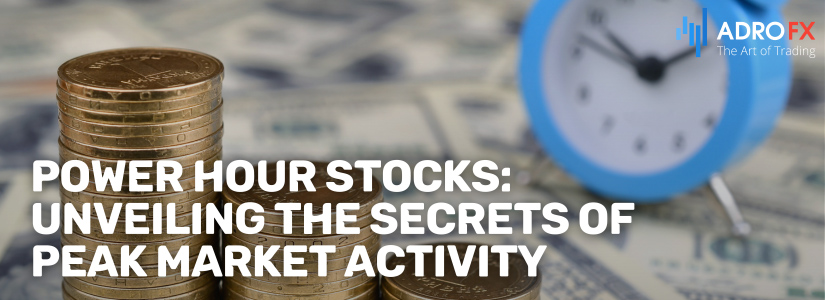Power Hour Stocks: Unveiling the Secrets of Peak Market Activity

In the bustling world of stock trading, timing can be everything. Enter the concept of "power hour stocks," a term that resonates among both part-time enthusiasts and seasoned traders alike. But what exactly are power hour stocks, and why do they wield such significance in the realm of trading?
Power hour stocks refer to those traded during specific hours of peak market activity, notably the opening and closing hours of the trading day. These hours, characterized by heightened trading volumes and volatility, offer fertile ground for traders seeking to capitalize on rapid market movements and maximize profit potential.
The allure of power hour stocks extends beyond mere opportunity; it caters to traders across the spectrum, from part-time investors looking to optimize their limited trading windows to full-time professionals aiming to extract maximum value from every market fluctuation. For part-time traders, power hour stocks offer a focused and efficient approach to navigating the market amidst busy schedules. Meanwhile, seasoned traders recognize the strategic importance of these hours in executing well-timed trades and harnessing market momentum to their advantage.
Understanding the Dynamics of Power Hour Trading
The rationale behind focusing on specific trading hours lies in the distinct market dynamics that characterize these periods. During power hours, such as the market open and close, trading volumes surge as institutional investors, hedge funds, and retail traders alike converge to execute their strategies. This surge in activity creates an environment ripe with opportunities for profit generation.
Market volatility, often perceived as a double-edged sword, forms the cornerstone of power hour trading strategies. While volatility entails heightened risk, it also presents unparalleled opportunities for profit. Power hour trading capitalizes on this volatility by strategically timing trades to exploit rapid price movements. By entering and exiting positions during these periods of peak activity, traders can potentially amplify their gains and minimize exposure to adverse market conditions.
In essence, understanding the dynamics of power hour trading is not merely about identifying optimal entry and exit points; it's about mastering the art of navigating the tumultuous seas of market volatility with precision and finesse.

Identifying Optimal Power Hours
Power hours primarily revolve around key time frames during the trading day, notably the market opening and closing hours. These periods, characterized by heightened trading volumes and volatility, hold significant appeal for traders seeking to capitalize on market momentum.
The market opening hour, typically from 9:30 am to 10:30 am Eastern Time, sets the tone for the trading day. As market participants react to overnight developments and news releases, trading volumes surge, creating ample opportunities for rapid price movements. Similarly, the market closing hour, occurring from 3:00 pm to 4:00 pm Eastern Time, represents a crucial juncture as traders rush to finalize their positions before the day's end.
These hours are particularly significant for traders due to the influx of market participants and the resulting surge in trading activity. The heightened volatility during power hours often leads to sharp price fluctuations, presenting traders with opportunities to capitalize on short-term market movements. Additionally, many traders prefer to execute their trades during these periods as liquidity tends to be higher, ensuring smoother order execution and tighter bid-ask spreads.
Factors Influencing Power Hour Trading
Several factors influence market activity during power hours, shaping trading patterns and market dynamics. Economic data releases play a pivotal role in driving market sentiment and investor behavior during power hours. Key economic indicators, such as employment reports, inflation data, and GDP figures, often trigger significant market movements, leading to heightened volatility during power hours.
Institutional trading patterns also exert a substantial influence on power hour trading. Large institutional investors, including hedge funds, mutual funds, and pension funds, frequently execute their trades during power hours, contributing to increased trading volumes and market volatility. Understanding institutional trading behavior and market sentiment can provide valuable insights for traders looking to navigate power hour trading effectively.
Moreover, geopolitical events, central bank announcements, and corporate earnings releases can impact market sentiment and contribute to volatility during power hours. Traders must stay abreast of these developments and adapt their trading strategies accordingly to capitalize on emerging opportunities and mitigate risks effectively.
Overall, a nuanced understanding of the factors influencing power hour trading is essential for traders seeking to navigate volatile market conditions and capitalize on short-term trading opportunities effectively.
Strategies for Power Hour Trading
In the world of power hour trading, where volatility reigns supreme, traders employ various strategies to seize opportunities and navigate market fluctuations.
Momentum Trading stands out as a favored approach, leveraging rapid price movements fueled by sudden shifts in market sentiment. Traders keenly identify stocks exhibiting strong momentum early in the trading session, strategically entering positions with the anticipation of continued trends during power hours.
Breakout Trading emerges as another compelling strategy, where traders meticulously pinpoint key support and resistance levels. These traders pounce on opportunities when prices breach these predefined thresholds during power hours, aiming to capitalize on significant price movements.
Scalping, a nimble and short-term strategy, finds its place in power hour trading. Traders swiftly enter and exit positions to exploit fleeting price fluctuations. This strategy allows traders to capture small, incremental profits throughout the trading session, making the most of rapid price swings.
Amidst the allure of potential profits, effective risk management is paramount. Traders safeguard their capital through prudent measures like setting Stop Loss orders, carefully managing position sizes, and diversifying their trading strategies and asset classes. These risk management techniques act as a shield against adverse market movements and help traders weather the storm of volatility inherent in power hour trading.
Benefits and Risks
Power hour trading presents a tantalizing array of benefits for traders. It offers abundant opportunities to capitalize on short-term market movements and generate profits swiftly. Moreover, focusing on specific trading hours with heightened activity enables traders to optimize their time and resources, enhancing efficiency and productivity.
However, alongside the promise of rewards, power hour trading carries inherent risks. The intensified volatility during these periods can lead to unpredictable price swings, exposing traders to heightened risk levels. Abrupt market fluctuations may result in significant losses if trades are not carefully managed, underscoring the critical importance of robust risk management strategies.
Furthermore, the surge in trading volumes during power hours may attract nefarious actors seeking to manipulate markets for personal gain. Traders must remain vigilant, navigating through potential market manipulation tactics to safeguard their interests and maintain market integrity.
In essence, while power hour trading offers tantalizing prospects for profit, it demands a nuanced understanding of market dynamics, coupled with disciplined risk management practices, to navigate the turbulent waters of volatility successfully.

Case Studies or Examples
Let's delve into real-life examples that showcase the effectiveness of power hour trading strategies:
Momentum Trading Success
Consider a trader who identifies a stock with strong pre-market momentum due to positive earnings results. With careful analysis and anticipation of continued momentum during power hours, the trader enters a long position at the market open. As expected, the stock experiences a surge in buying pressure during power hours, allowing the trader to capitalize on the upward momentum and secure substantial profits by strategically exiting the position before the market close.
Key Takeaway:
The success of this momentum trading strategy underscores the importance of thorough pre-market analysis and swift execution during power hours. By identifying stocks with strong momentum and capitalizing on rapid price movements, traders can seize lucrative opportunities and maximize profitability.
Breakout Trading Strategy
Imagine a trader who monitors a stock approaching a key resistance level in the pre-market session. Recognizing the potential for a breakout during power hours, the trader patiently waits for confirmation of a bullish breakout above the resistance level. Once the breakout occurs, the trader enters a long position with a carefully placed Stop Loss to manage risk. The stock continues its upward trajectory during power hours, allowing the trader to ride the breakout momentum and secure significant gains.
Key Takeaway:
This breakout trading example highlights the importance of identifying key support and resistance levels and waiting for confirmation before entering a trade. By exercising patience and discipline, traders can effectively capitalize on breakout opportunities and mitigate the risk of false breakouts.
Conclusion
In conclusion, power hour trading offers traders a unique opportunity to capitalize on heightened market volatility and maximize profitability. By focusing on specific trading hours with increased activity, traders can strategically execute trades and seize lucrative opportunities in the stock market.
Throughout this article, we've explored various strategies and risk management techniques tailored for power hour trading, emphasizing the importance of thorough analysis and disciplined execution. From momentum trading to breakout strategies, successful power hour trading requires a combination of skill, patience, and risk management.
It's essential for traders to understand the dynamics of power hour trading and leverage this knowledge effectively to navigate volatile market conditions and achieve success in the stock market. By embracing the principles outlined in this article and adopting a proactive approach to power hour trading, traders can enhance their trading performance and unlock their full potential in the dynamic world of stock trading.
About AdroFx
Established in 2018, AdroFx is known for its high technology and its ability to deliver high-quality brokerage services in more than 200 countries around the world. AdroFx makes every effort to keep its customers satisfied and to meet all the trading needs of any trader. With the five types of trading accounts, we have all it takes to fit any traders` needs and styles. The company provides access to 115+ trading instruments, including currencies, metals, stocks, and cryptocurrencies, which make it possible to make the most out of trading on the financial markets. Considering all the above, AdroFx is the perfect variant for anyone who doesn't settle for less than the best.










